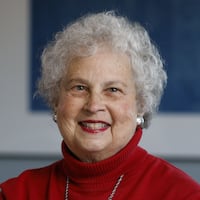It’s about this time of year that non-Jewish friends and colleagues begin to ask about the Jewish holidays. They’re typically apologetic because they’re never certain about the dates.
Well, guess what? Jews don’t know the dates either! In fact, they’re probably surreptitiously checking their calendars when you ask the question.
That’s because the secular New Year always falls on December 31 and January 1, but the Jewish New Year — Rosh Hashana — always seems to be moving around. This year it begins on Friday night, Sept. 18.
Actually, if you go by the Jewish lunar calendar the date stays the same, but it falls on different days of the Gregorian calendar used by the rest of the world. It’s usually in September, sometimes in early October. This Jewish New Year is 5770.
New Year’s Day is officially an American holiday so everyone gets the day off.
Jews typically refrain from working or going to school on Rosh Hashana, so they’ll need to take a vacation day or make up homework and tests.
Our regular New Year lasts 24-hours plus the hangover. Though Jews recite blessings over wine at holiday meals, there’s rarely a hangover. Depending upon your level of observance, Rosh Hashana lasts one or two days. Like New Year’s Eve, Jewish holidays always begin at sundown.
The mood of the two holidays is pretty different. Our American New Year is filled with dancing, hooting and hollering, good cheer. Parties held at homes, hotels, restaurants abound. Many people like to dress up in fancy garb.
Rosh Hashana ushers in the Jewish High Holy Days or Days of Awe, a period of prayer and reflection that ends 10 days later with Yom Kippur, the Day of Atonement. The mood is more somber and serious. Time is divided between home and synagogue, with relatives often coming from out-of-town. People dress nicely for family gatherings and religious services.
Food, of course, is important for both. For the secular New Year, it’s about champagne and hors d’oeuvres.
Jewish families symbolically incorporate something sweet into their holiday lunches and dinners to signify a sweet new year: round sweet raisin challah, apples dipped in honey, honey cake for dessert. In between there’s chicken soup, roasted chicken or brisket, sweet noodle kugels (pudding).
When it comes to the greetings, we wish one another “Happy New Year” for the secular year, and many Jews greet one another in the same manner for Rosh Hashana. If you want to be completely correct, however, the Jewish greeting is “Shana Tova,” Hebrew for a “good year.”
Both holidays offer the opportunity for a new beginning and the chance to transform ourselves into better human beings. So it’s no wonder resolutions are common to both. On Rosh Hashana, it’s usually less about diet and exercise, and more about asking God and others for forgiveness, forgiving those who’ve hurt us, and reflecting on our own personal growth.
Finally, about those hats and horns. For the secular New Year, hats are colorful, decorative, disposable and made out of paper.
For Rosh Hashana, you’ll see two types of head coverings: the skullcap or kippah donned for synagogue worship (some observant Jews choose to wear them at all times) and the hats worn to synagogue by religious women in the same way many women often choose to wear hats to church.
As for the horns, a solid toot on the New Year’s eve version sounds a bit like the blast from the ram’s horn, or shofar, the instrument that traditionally ushers in the Jewish New Year. But, trust me, the paper ones are a heck of a lot easier to blow.
Contact this reporter at (937) 225-2440 or mmoss@DaytonDailyNews.com.
About the Author
